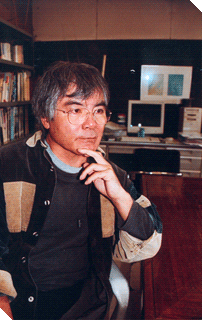Biography
1943 Born in Hiroshima, Japan.
1965 Graduated from art school.
1968 -
1991 Worked in a stone company in Hiroshima and worked as an artist at the same time.
1992 - Established his own company: Stone Studio.
2003 Lives and works in Hiroshima City.
|
 |
|
Preface
Suhama Motoko, a curator at the Hiroshima City Museum of Contemporary Art, introduced me to Mr. Ishimaru. He has done numerous projects in public and private spaces as both an artist and as head of a stone company in Hiroshima.
|
|
|
Interview
Recorded on October 22, 2002
 Sato: Could you explain something about the kind of work you have been doing? Sato: Could you explain something about the kind of work you have been doing?
 Ishimaru: I have been working with stone as a main element in architectural work, monuments and my own artwork since I started. Even though stone has always been the primary material, I sometimes use wood and other materials to make objects. Ishimaru: I have been working with stone as a main element in architectural work, monuments and my own artwork since I started. Even though stone has always been the primary material, I sometimes use wood and other materials to make objects.
|
|
|
When I worked as the head of the Stone Company in Hiroshima city, we did a project for a memorial monument; the Aioi Bridge in front of the Atomic Dome and the Hiroshima City Museum. The work was constructed entirely out of stone parts.
 Sato: What has changed in the way stones are used over the last 30 years? Sato: What has changed in the way stones are used over the last 30 years?
 Ishimaru: Stone masonry existed as a profession in Japan 30 years ago. After the diamond-cutting machine was invented, there was no need for stonemasons anymore. Nowadays, those who can chisel, are specially skilled people likely to have studied Arts and crafts. We cannot manufacture stone in the traditional way anymore. There are still many stonemasons in China so every now and then we work together with them. Ishimaru: Stone masonry existed as a profession in Japan 30 years ago. After the diamond-cutting machine was invented, there was no need for stonemasons anymore. Nowadays, those who can chisel, are specially skilled people likely to have studied Arts and crafts. We cannot manufacture stone in the traditional way anymore. There are still many stonemasons in China so every now and then we work together with them.
 Sato: How has your relationship with stone changed after the introduction of machine? Sato: How has your relationship with stone changed after the introduction of machine?
 Ishimaru: Because stone is heavy and sturdy material, it is difficult to handle. For example, it would be impossible to lift a 30 cm x 30 cm rock by hand. That is an understanding of heaviness. If you use a heated chisel, you can physically experience the gumminess, heat, coldness, softness and hardness of stone. Nowadays however, we use diamond cutters to chisel and shape stone; you can easily handle the material without having this physical experience.
If you erect a 1000 kg piece of stone with a machine, it becomes sculpture. Before it was impossible to have a 1000 kg piece of stone standing like in Stonehenge, so that action of having it standing turns it into art. It is a matter of how you are able to control the heaviness of stone. Ishimaru: Because stone is heavy and sturdy material, it is difficult to handle. For example, it would be impossible to lift a 30 cm x 30 cm rock by hand. That is an understanding of heaviness. If you use a heated chisel, you can physically experience the gumminess, heat, coldness, softness and hardness of stone. Nowadays however, we use diamond cutters to chisel and shape stone; you can easily handle the material without having this physical experience.
If you erect a 1000 kg piece of stone with a machine, it becomes sculpture. Before it was impossible to have a 1000 kg piece of stone standing like in Stonehenge, so that action of having it standing turns it into art. It is a matter of how you are able to control the heaviness of stone.
The Pyramids seem to be one of the seven mysteries of the world, but I do not think they are mysterious at all. They can be mysterious to the people who imagine the work being done by modern cranes and so on. If you imagine a different economical, space- and time frame where moving a 1000 kg stone would take 10 years, it would be possible to build pyramids. It shows the limits of a perspective that is supported by one single scientific idea.
 Sato: Could you talk about your installation work, which is based on your experience of the weight of stone? Sato: Could you talk about your installation work, which is based on your experience of the weight of stone?
 Ishimaru: In 1987, seven young artists wanted to make artworks in a valley near Hiroshima. As I was a salaried man, I joined the group only on Saturday and Sunday. The location was in the mountains, there was no audience, we exhibited the results of the installations by using video recordings and we made books.
First I went up to a hill beside the river, I secured a rope on the tree and hung on the rope to reach a stone that was lying in the river bedding. Then I made a hole in the stone to connect the rope so I could anchor the tree. I did this 10 to 15 times with different trees and the same stone. As a result, the stone started moving and finally, controlled by the ropes floated above the centre of the river. (Fig.1) I knew something about the flexibility of trees, because I played Tarzan in my childhood. We played a lot with stones and ropes. This was an installation I made with children. After the installation was finished, everything returned the way I found it except for the hole in the stone. Ishimaru: In 1987, seven young artists wanted to make artworks in a valley near Hiroshima. As I was a salaried man, I joined the group only on Saturday and Sunday. The location was in the mountains, there was no audience, we exhibited the results of the installations by using video recordings and we made books.
First I went up to a hill beside the river, I secured a rope on the tree and hung on the rope to reach a stone that was lying in the river bedding. Then I made a hole in the stone to connect the rope so I could anchor the tree. I did this 10 to 15 times with different trees and the same stone. As a result, the stone started moving and finally, controlled by the ropes floated above the centre of the river. (Fig.1) I knew something about the flexibility of trees, because I played Tarzan in my childhood. We played a lot with stones and ropes. This was an installation I made with children. After the installation was finished, everything returned the way I found it except for the hole in the stone.
People, who have heard about this installation, wanted to do the project in the city. The district area of Hiroshima is famous because of its bamboo, we decided to make the same installation with bamboo in a park. 88 bamboo pipes needed to be installed in the ground, so we had to dig out between 80cm and 1 meter for each hole. I wanted to involve many people in the town, especially young people, to become part of the project. The purpose of the project was to create a Matsuri (festival).

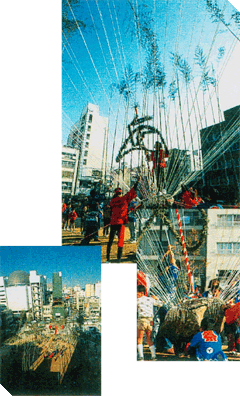
In NAMIKI Dori
At that period I was thinking what a festival could be. All of us enjoyed the project very much: the effect of pulling the rope collectively to bend the bamboo and experience the heaviness of the stone, the great feeling to sense and see the stone was moving. I still remember it as a great physical experience.
 Sato: Recently there have been some initiatives in Japan which are re-discovering the festival as a collective experience. My friend also became interested in this idea and now she organizes the Moon theatre in Kanazawa. She does dance performances once a month to celebrate full moon. Sato: Recently there have been some initiatives in Japan which are re-discovering the festival as a collective experience. My friend also became interested in this idea and now she organizes the Moon theatre in Kanazawa. She does dance performances once a month to celebrate full moon.
 Ishimaru: My project was about discovering the festival. In Japan there used to be many different kinds of communities, for example villages, but now the reality of the community has changed. It is very difficult to do a real festival, but there are many events. Ishimaru: My project was about discovering the festival. In Japan there used to be many different kinds of communities, for example villages, but now the reality of the community has changed. It is very difficult to do a real festival, but there are many events.
 Sato: What are the differences between a festival and an event? Sato: What are the differences between a festival and an event?
 Ishimaru: A festival is generated naturally, for example when people want to express their gratitude for the gathered harvest. It is historically rooted like thanksgiving. In a festival, you have to be actively involved to make your own fun. The event is a pre-organized activity so to say; fun is implied like it is at a playing ground. In an event the public don't need to create anything. Ishimaru: A festival is generated naturally, for example when people want to express their gratitude for the gathered harvest. It is historically rooted like thanksgiving. In a festival, you have to be actively involved to make your own fun. The event is a pre-organized activity so to say; fun is implied like it is at a playing ground. In an event the public don't need to create anything.
|
|
The aioi bridge with its T-shape is said to be the aiming point of the Atomic Bomb. 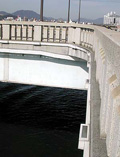
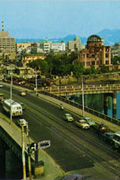
|
We still have traditional festivals in Japan like Onbashira. Sometimes festivals can be very dangerous and people might loose their life, so it is risky and difficult to create new festivals nowadays.
 Sato: When did you organize your own festival? Sato: When did you organize your own festival?
 Ishimaru: It was from 1991 till 1998. I did not advertise the festival. It stopped naturally just when everyone started to know it. In that period a few good artists from Tokyo joined the festival. A group of young people constructed a stage for sacred dances, musicals and theatre. Ishimaru: It was from 1991 till 1998. I did not advertise the festival. It stopped naturally just when everyone started to know it. In that period a few good artists from Tokyo joined the festival. A group of young people constructed a stage for sacred dances, musicals and theatre.
 Sato: Did you use bamboo in other works as well? Sato: Did you use bamboo in other works as well?
 Ishimaru: Yes, I am interested in the flexibility of the material rather than its aesthetic side. Ishimaru: Yes, I am interested in the flexibility of the material rather than its aesthetic side.
 Sato: I have the impression that you use materials not for their symbolic form or beauty, but rather for their character. Could you explain this? Sato: I have the impression that you use materials not for their symbolic form or beauty, but rather for their character. Could you explain this?
 Ishimaru: In my generation physical sensibility is a very important subject, everyone has a body; if you got hurt, you feel pain. This is fundamental and common to everyone. Furthermore, it is important to maintain a balance between a physical sensibility and conceptual thought, which means a balance between intellect and interest. Ishimaru: In my generation physical sensibility is a very important subject, everyone has a body; if you got hurt, you feel pain. This is fundamental and common to everyone. Furthermore, it is important to maintain a balance between a physical sensibility and conceptual thought, which means a balance between intellect and interest.
 Sato: You take the character of a material as a physical entity and that is based on your work. Do you think there are relations between this idea and the childhood experience you had of the nuclear bomb?
(He mostly feared the A-bomb because of the accounts he heard and stories he read, not because he remembered the physicality of the experience. He realized that it was important to obtain the right information before he could form his opinion on what happened. I thought later, that this might have influenced his preference to have a physical connection with his material. ed.) Sato: You take the character of a material as a physical entity and that is based on your work. Do you think there are relations between this idea and the childhood experience you had of the nuclear bomb?
(He mostly feared the A-bomb because of the accounts he heard and stories he read, not because he remembered the physicality of the experience. He realized that it was important to obtain the right information before he could form his opinion on what happened. I thought later, that this might have influenced his preference to have a physical connection with his material. ed.)
 Ishimaru: I think that this is an important discussion. When I experienced the nuclear bomb, I was two years old. I do not remember anything. It did not have any immediate effect on me, neither mentally nor physically. My parents did experience the disaster and talked a lot in detail about what had happened. Their stories were very realistic, I was confused and wondered how they could talk that way about it. It seemed as if they were almost proud of their experience. Ishimaru: I think that this is an important discussion. When I experienced the nuclear bomb, I was two years old. I do not remember anything. It did not have any immediate effect on me, neither mentally nor physically. My parents did experience the disaster and talked a lot in detail about what had happened. Their stories were very realistic, I was confused and wondered how they could talk that way about it. It seemed as if they were almost proud of their experience.
I was part of the first generation that got educated in school right after the war. Science gave us an insight into the invisible side effects of radioactivity like the decomposition of genes. That was not a physical experience, but an idea. That idea together with the story of my parents created a deep fear inside of me. I don't have the same experiences as the A-bomb survivors who got burned in the fires and who lost all their hair. When I was in primary school, I heard many stories about the side effects of the A-bomb and I was very afraid, especially when I lost some hair or I had a bloody nose, even though these things are normal and occur. Deep fear I more or less discovered later. If you got into a fight with somebody, you bled and felt pain that was it! It was tangible and simple. On the contrary it can be more frightening and dangerous if something is happening that you don't understand. You cannot protect yourself. You need information, intellect, and knowledge to understand what is going on, which is far away from our everyday life.
Long time ago you could survive, if you knew the direction of the wind, but now you need to be educated and have the right information to make the right decisions. The world where you survived on intuition used to be balanced with emotion, but now you can live without knowing the direction of the wind. Especially after the terrorist attack in New York, many people realized how important intellect and knowledge are. If we express, and act on every emotion we have, it would be very dangerous. The moment we have a reason, we are allowed do everything, for example, murder as a motive of revenge. The war was also started on this pretext.
 Sato: Propaganda and reality are very different things aren't they? When I was in New York on September 11, I saw a group of firemen walking down the street, at the same time I saw President Bush on T.V. My reactions towards the firemen and Bush were very different: What Bush said sounded like propaganda under the pretence of an alleged terrorist attack. What I saw on the street stimulated my imagination on what had happened and what was going on in the World Trade Centre. It was a horrible incident, but it is too direct to fight back with a feeling of revenge, furthermore I think it is dishonest to use fear and negative emotions of people to gain political benefit. This incident required me to thoughtfully re-consider the situation of the world I live in. The first two days after the attack I watched T.V. with my friends in New York. It seemed they broadcasted not only the reality of what happened but also their distorted version of what had happened. Sato: Propaganda and reality are very different things aren't they? When I was in New York on September 11, I saw a group of firemen walking down the street, at the same time I saw President Bush on T.V. My reactions towards the firemen and Bush were very different: What Bush said sounded like propaganda under the pretence of an alleged terrorist attack. What I saw on the street stimulated my imagination on what had happened and what was going on in the World Trade Centre. It was a horrible incident, but it is too direct to fight back with a feeling of revenge, furthermore I think it is dishonest to use fear and negative emotions of people to gain political benefit. This incident required me to thoughtfully re-consider the situation of the world I live in. The first two days after the attack I watched T.V. with my friends in New York. It seemed they broadcasted not only the reality of what happened but also their distorted version of what had happened.
|
|
Onbashira festival
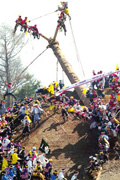
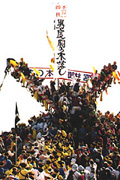
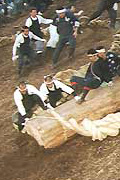
|
 Ishimaru: Yes, I can understand. You went to Eda-island, didn't you? I do not know what type of presentation they do nowadays. When I went there, I saw the war paintings and the last letters of Kamikaze pilots; it really made me cry because it showed their purity and innocence. Young men 16 to 18 years old really believed in the war and faced death for the sake of their country. It was so pure and it made me wonder. Ishimaru: Yes, I can understand. You went to Eda-island, didn't you? I do not know what type of presentation they do nowadays. When I went there, I saw the war paintings and the last letters of Kamikaze pilots; it really made me cry because it showed their purity and innocence. Young men 16 to 18 years old really believed in the war and faced death for the sake of their country. It was so pure and it made me wonder.
 Sato: I cried a lot when I was in Eda-island. My boyfriend is Dutch, but he too was very moved by the letters. They evoke similar feelings on everybody. Sato: I cried a lot when I was in Eda-island. My boyfriend is Dutch, but he too was very moved by the letters. They evoke similar feelings on everybody.
 Ishimaru: Yes, though the beauty may also be perceived as a feeling of revenge and of course nowadays things have became much more complicated. Ishimaru: Yes, though the beauty may also be perceived as a feeling of revenge and of course nowadays things have became much more complicated.
 Sato: It was a simple pureness. Sato: It was a simple pureness.
 Ishimaru: That is right. Although it was a conspiracy, at that period innocent and pure young people were made to sacrifice their lives. Ishimaru: That is right. Although it was a conspiracy, at that period innocent and pure young people were made to sacrifice their lives.
 Sato: the letters to their families especially impressed me. I am not sure if they all wanted to give their life for the emperor. Some of them may be, but---. I have heard stories of kamikaze pilots who were conscripts (Eda Island housed the school for elite soldiers): in the evening they talked in their private room why they were willing to commit suicide. It became quite clear that Japan was going to lose the war: in spite of that fact they thought that if they reject the offer, their family would be ostracized. They had a strong conviction to protect their family and their country, that moved me a lot. I also heard that right before many Kamikaze pilots crashed they said the word, "Mother". Sato: the letters to their families especially impressed me. I am not sure if they all wanted to give their life for the emperor. Some of them may be, but---. I have heard stories of kamikaze pilots who were conscripts (Eda Island housed the school for elite soldiers): in the evening they talked in their private room why they were willing to commit suicide. It became quite clear that Japan was going to lose the war: in spite of that fact they thought that if they reject the offer, their family would be ostracized. They had a strong conviction to protect their family and their country, that moved me a lot. I also heard that right before many Kamikaze pilots crashed they said the word, "Mother".
 Ishimaru: It probably doesn't matter so much if they died for their mother or for the emperor. I think it is more important to hear their voice on the moment they loose their life. Ishimaru: It probably doesn't matter so much if they died for their mother or for the emperor. I think it is more important to hear their voice on the moment they loose their life.
 Sato: I have been to Mugonkan. It was moving to see the work of the art students who died in the war. The presentation however, shows them as if they are holy, yet they might have killed people in China or other Asian countries. Eda-island very clearly presents those who died in the suicide attacks, as gods. I found it to be too one sided, but I was moved by the pureness of the soldiers who sacrificed their life. What do you think about this? Sato: I have been to Mugonkan. It was moving to see the work of the art students who died in the war. The presentation however, shows them as if they are holy, yet they might have killed people in China or other Asian countries. Eda-island very clearly presents those who died in the suicide attacks, as gods. I found it to be too one sided, but I was moved by the pureness of the soldiers who sacrificed their life. What do you think about this?
 Ishimaru: The problem is that we have become both victims and perpetrators. It depends on your age; things can become both fair and unfair. I cannot say anything about the presentation you're referring to. It is important to understand more about the sorrow of human beings. We humans have this terrible habit of doing all the things that the animals refrain from doing. Ishimaru: The problem is that we have become both victims and perpetrators. It depends on your age; things can become both fair and unfair. I cannot say anything about the presentation you're referring to. It is important to understand more about the sorrow of human beings. We humans have this terrible habit of doing all the things that the animals refrain from doing.
 Sato: You mean to say that our sense of violence lets us survive as well. Yet animals live on their instinct. We nearly lost our instinct. Sato: You mean to say that our sense of violence lets us survive as well. Yet animals live on their instinct. We nearly lost our instinct.
 Ishimaru: According to science it is called natural selection. First of all, is it true that only human beings are surviving? Our life might be one moment in a long cosmic history or there might be other species living on another planet that are much more advanced than us. Who knows? Human beings need to recognize that they are capable of doing anything, if they need to, want to, or have to. Ishimaru: According to science it is called natural selection. First of all, is it true that only human beings are surviving? Our life might be one moment in a long cosmic history or there might be other species living on another planet that are much more advanced than us. Who knows? Human beings need to recognize that they are capable of doing anything, if they need to, want to, or have to.
 Sato: If we talk about the reason why war occurs, the interests of countries are an obvious cause. However, war itself is a consequence of the battle for survival and the devastation caused on others through the use of power. Sato: If we talk about the reason why war occurs, the interests of countries are an obvious cause. However, war itself is a consequence of the battle for survival and the devastation caused on others through the use of power.
 Ishimaru: This refers to the basic nature of human beings, not only to what is good and what is bad. Ishimaru: This refers to the basic nature of human beings, not only to what is good and what is bad.
 Sato: Hiroshima represents the forfeit of the nuclear age, this depiction is used to explain the U.S.' excuse to end the war by dropping the Atomic bomb on Hiroshima and Nagasaki.
In the U.S.A. they have strong feelings of revenge, moreover the government uses it as an incentive for foreign policy. Sato: Hiroshima represents the forfeit of the nuclear age, this depiction is used to explain the U.S.' excuse to end the war by dropping the Atomic bomb on Hiroshima and Nagasaki.
In the U.S.A. they have strong feelings of revenge, moreover the government uses it as an incentive for foreign policy.
|
|
Kamikaze pilots
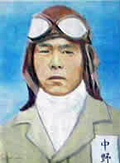
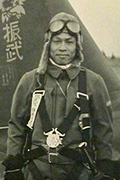
|
 Ishimaru: We have a strong feeling of revenge as well, don't we? At least in Hiroshima people don't bare the consciousness of being a victim. Also there have not been any artists in Hiroshima who made artworks of direct disastrous scenes. It almost came from the outside. Only I found the paintings made by the A-bomb survivors, which NHK (the national Japanese T.V. channel) invited and are presented in Hirotane, incredibly realistic and good. I think no painter can paint like that. In my case, even though I lost my stepfather and relatives, I don't have these feelings of revenge or of being a victim I think it is about different perspectives like I mentioned before. Ishimaru: We have a strong feeling of revenge as well, don't we? At least in Hiroshima people don't bare the consciousness of being a victim. Also there have not been any artists in Hiroshima who made artworks of direct disastrous scenes. It almost came from the outside. Only I found the paintings made by the A-bomb survivors, which NHK (the national Japanese T.V. channel) invited and are presented in Hirotane, incredibly realistic and good. I think no painter can paint like that. In my case, even though I lost my stepfather and relatives, I don't have these feelings of revenge or of being a victim I think it is about different perspectives like I mentioned before.
 Sato: I think that Hiroshima is a city that consists of different layers and complex matters. The inhabitants of Hiroshima constitute of first, second and third generation A-bomb survivors, of those who came back to rebuild the city after the war, and the complete outsiders.
There were periods during the U.S. military occupation in Hiroshima where disasters were hidden from the outside world for political purposes. Left and right wing politicians in Japan also used Hiroshima as a political tool. The survivors didn't want to be used for those purposes. What happened in Hiroshima still continues in other parts of the world. For example the united military force used the uranium bomb in the Gulf war. The weapon polluted parts of the country and increased the cancer rate in Iraq. It is horrible that some countries are still testing nuclear bombs and continue to use them. Sato: I think that Hiroshima is a city that consists of different layers and complex matters. The inhabitants of Hiroshima constitute of first, second and third generation A-bomb survivors, of those who came back to rebuild the city after the war, and the complete outsiders.
There were periods during the U.S. military occupation in Hiroshima where disasters were hidden from the outside world for political purposes. Left and right wing politicians in Japan also used Hiroshima as a political tool. The survivors didn't want to be used for those purposes. What happened in Hiroshima still continues in other parts of the world. For example the united military force used the uranium bomb in the Gulf war. The weapon polluted parts of the country and increased the cancer rate in Iraq. It is horrible that some countries are still testing nuclear bombs and continue to use them.
Underneath the soil of Hiroshima city there must be many unknown bones. I never felt aware of this when I was there. It can be an influence of what I know, some photos and monuments I have seen in Hiroshima, but it can also be an impression I got from the city itself; there are hardly any old Japanese houses or traces of history like you see in other Japanese cities. I must say that it's a strange and artificial experience to see the history of a city being represented only by monuments.
What I felt on September 11 in New York was different; more or less the awareness of present danger. The image of the crashing airplane reminded me of my father. The experiences of Hiroshima and New York blurred my sense of the past and the present: The terrorist attack involved innocent people, not comparable with the attacks of kamikaze pilots in the time of war. Still I feel for my father, that he was a victim, but I didn't feel I was a victim in New York.
 Ishimaru: Did you suddenly remember things about your father when you were in New York? Ishimaru: Did you suddenly remember things about your father when you were in New York?
 Sato: No, I started thinking about my father 7 to 8 years ago. I do not clearly remember how it started, but I talked about him with my close European friends. They asked me why I did not try to find him. Their reaction surprised me, because in Japan it seemed like it was better not to touch the issue, as if it smelled bad. My mother has hardly ever talked about him. I started collecting material and information about kamikaze pilots, and finally made a print work with it at the Jan van Eyck Academy. The print showed a photo of a kamikaze pilot, which my friend found in the train. The story of my father is private, so it might be better not to mix-up that with my present interest related to Hiroshima and September 11. Sato: No, I started thinking about my father 7 to 8 years ago. I do not clearly remember how it started, but I talked about him with my close European friends. They asked me why I did not try to find him. Their reaction surprised me, because in Japan it seemed like it was better not to touch the issue, as if it smelled bad. My mother has hardly ever talked about him. I started collecting material and information about kamikaze pilots, and finally made a print work with it at the Jan van Eyck Academy. The print showed a photo of a kamikaze pilot, which my friend found in the train. The story of my father is private, so it might be better not to mix-up that with my present interest related to Hiroshima and September 11.
 Ishimaru: I recommend you to mix-up things even more. Political situations change through the years but some sort of basic human values should exist and should not change. Therefore, I think it is important to present political and social matters from the perspective of private circumstances. For example, there are seven different groups of A-bombs survivors in Hiroshima. Even though they have different backgrounds and different personal circumstances, they all have a their own opinion about Hiroshima. The 6th of August is the most important day in Hiroshima and thousands of people gather in Hiroshima. Many groups of people travel to Hiroshima, yet most of us who live in Hiroshima, continue working. Ishimaru: I recommend you to mix-up things even more. Political situations change through the years but some sort of basic human values should exist and should not change. Therefore, I think it is important to present political and social matters from the perspective of private circumstances. For example, there are seven different groups of A-bombs survivors in Hiroshima. Even though they have different backgrounds and different personal circumstances, they all have a their own opinion about Hiroshima. The 6th of August is the most important day in Hiroshima and thousands of people gather in Hiroshima. Many groups of people travel to Hiroshima, yet most of us who live in Hiroshima, continue working.
 Sato: I came across this in a book called, "Note in Hiroshima," by Ooe Kenzaburo. In 1962 or 1963 he got a handicapped baby and he went to Hiroshima to join a peace ceremony on the 6th of August The ceremony itself did not help him, but the A-bomb survivors and doctors gave him a great impression of the dignity of human beings. He is one of those people who became involved with Hiroshima through personal circumstances. Sato: I came across this in a book called, "Note in Hiroshima," by Ooe Kenzaburo. In 1962 or 1963 he got a handicapped baby and he went to Hiroshima to join a peace ceremony on the 6th of August The ceremony itself did not help him, but the A-bomb survivors and doctors gave him a great impression of the dignity of human beings. He is one of those people who became involved with Hiroshima through personal circumstances.
 Ishimaru: I haven't read his book. I refuse to look at Hiroshima as a victimized city or as something special; we are the same as everyone else. There are so many miseries in the world. Some people get problems not only physically, but also mentally and that can have a great impact on their lives. It is not about being a victim or not, it is a matter of human beings who did wrong and now we have to make up for it. In Japan, for example we developed a car that is pollution free. Maybe it is extreme to say, but the fundamental character of science provides us with incomprehensible problems that we must solve systematically with our intellect in order to progress. A good example is nuclear energy. It exists beyond our physical understanding; you cannot see it, you can't tell whether it can harm you or not. The effect of nuclear energy became clear after the examination of the results of what happened in Hiroshima and Nagasaki. Although we immediately experience the physical effect it has on us, it is important to understand the things with our intellect. You experienced the terrorist attack in New York; do you think it will remain a physical experience for you? Ishimaru: I haven't read his book. I refuse to look at Hiroshima as a victimized city or as something special; we are the same as everyone else. There are so many miseries in the world. Some people get problems not only physically, but also mentally and that can have a great impact on their lives. It is not about being a victim or not, it is a matter of human beings who did wrong and now we have to make up for it. In Japan, for example we developed a car that is pollution free. Maybe it is extreme to say, but the fundamental character of science provides us with incomprehensible problems that we must solve systematically with our intellect in order to progress. A good example is nuclear energy. It exists beyond our physical understanding; you cannot see it, you can't tell whether it can harm you or not. The effect of nuclear energy became clear after the examination of the results of what happened in Hiroshima and Nagasaki. Although we immediately experience the physical effect it has on us, it is important to understand the things with our intellect. You experienced the terrorist attack in New York; do you think it will remain a physical experience for you?
 Sato: Under similar circumstances: yes. Every day I started to feel less well. Four days after the attacks, I was able to travel back to the Netherlands. It was funny that as soon as I got on the airplane, I felt better. I can imagine that people are influenced by the daily situation in a war, even though they will get used to it. Sato: Under similar circumstances: yes. Every day I started to feel less well. Four days after the attacks, I was able to travel back to the Netherlands. It was funny that as soon as I got on the airplane, I felt better. I can imagine that people are influenced by the daily situation in a war, even though they will get used to it.
 Ishimaru: If you experience something physical, it might shock you and a reaction would naturally come out of that. But I did not remember anything as a child, so what could I do with the information? The only way to cope with the facts was by acquiring knowledge and understanding of what had happened. Ishimaru: If you experience something physical, it might shock you and a reaction would naturally come out of that. But I did not remember anything as a child, so what could I do with the information? The only way to cope with the facts was by acquiring knowledge and understanding of what had happened.
 Sato: I have one more question. I have done some interviews with children in the Hiroshima peace park. I asked them about their thoughts of what they have heard and seen in Hiroshima. Most of them answered without thinking that they felt fear and sympathy. There was a ceremony in front of the Children's peace memorial. Many children are visiting Hiroshima each season as a school activity or excursion. They were reading their own writing out loud in front of the memorial that was dedicated to the children who were killed by the Atomic Bomb. The content was emotional. I was very moved by it, but I had the suspicion that the activity was insisted on by the school. What do you think? Sato: I have one more question. I have done some interviews with children in the Hiroshima peace park. I asked them about their thoughts of what they have heard and seen in Hiroshima. Most of them answered without thinking that they felt fear and sympathy. There was a ceremony in front of the Children's peace memorial. Many children are visiting Hiroshima each season as a school activity or excursion. They were reading their own writing out loud in front of the memorial that was dedicated to the children who were killed by the Atomic Bomb. The content was emotional. I was very moved by it, but I had the suspicion that the activity was insisted on by the school. What do you think?
 Ishimaru: I also doubt if children can say such noble things. It is the power of education just like the American reprisal of the war against Afghanistan can be thought in schools as a fair war. What is fair and what is unfair? That in itself can be part of an education as well. Japanese children say that Hiroshima and Nagasaki should never happened again and we should keep the peace. It sounds like the answer of a honorary student. Ishimaru: I also doubt if children can say such noble things. It is the power of education just like the American reprisal of the war against Afghanistan can be thought in schools as a fair war. What is fair and what is unfair? That in itself can be part of an education as well. Japanese children say that Hiroshima and Nagasaki should never happened again and we should keep the peace. It sounds like the answer of a honorary student.
 Sato: The children answered my questions spontaneously so it appeared to be their direct answer. Inside of the museum they were afraid of looking at the pictures of wounded people. I also remember children saying that they would rather die than be in a similar situation and deal with the after effects of the war. On the other hand it is contradictory to see how accustomed they have become to playing violent computer games and watching horrible scenes on the T.V. and in the cinema. Sato: The children answered my questions spontaneously so it appeared to be their direct answer. Inside of the museum they were afraid of looking at the pictures of wounded people. I also remember children saying that they would rather die than be in a similar situation and deal with the after effects of the war. On the other hand it is contradictory to see how accustomed they have become to playing violent computer games and watching horrible scenes on the T.V. and in the cinema.
 Ishimaru: That is because of their sensitivity towards fear. Besides, I may say things that are incomprehensible and confusing, but the ceremonies and rituals conducted by children can also suffice to relieve them of the suffering in Hiroshima, even though it might seem contradictory. Ishimaru: That is because of their sensitivity towards fear. Besides, I may say things that are incomprehensible and confusing, but the ceremonies and rituals conducted by children can also suffice to relieve them of the suffering in Hiroshima, even though it might seem contradictory.
 Sato: I cried to listen the talk. I myself feel complicated. Rationally I am suspicious about these kinds of activities, but I also haven't experienced the war. I do not know what war can be like. May be I saw and experienced a very small part of what it can be on September 11 in New York. Sato: I cried to listen the talk. I myself feel complicated. Rationally I am suspicious about these kinds of activities, but I also haven't experienced the war. I do not know what war can be like. May be I saw and experienced a very small part of what it can be on September 11 in New York.
 Ishimaru: I suppose what is important to you is that you started to cry by the chance to be in N.Y. What is it? In your head you do not want to cry, but you cry. It can be an essential subject to pursuit. The physical reaction like crying can be a motivation. In my case I haven't experienced the Atomic bomb in a sense so that in my life I have been concerning with what that abstract and invisible experience means to me. Ishimaru: I suppose what is important to you is that you started to cry by the chance to be in N.Y. What is it? In your head you do not want to cry, but you cry. It can be an essential subject to pursuit. The physical reaction like crying can be a motivation. In my case I haven't experienced the Atomic bomb in a sense so that in my life I have been concerning with what that abstract and invisible experience means to me.
|
|
"Unforgettable fire" paintings by A-bomb survivors



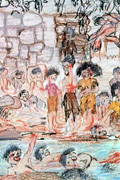
|
Postscript
After the interview I went with Ishimaru to the Hiroshima City Museum, which was built on a hill in the Higi Yama Park. Mr. Ishimaru told me that he played here a lot in his childhood and on a few occasions he found human bones. They were the remains of those who escaped to the hill. I could imagine what the circumstances were like where he grew up.
It was an interview that made me very emotional. My feelings intensified during the train ride on the way to Hiroshima. I read the letters of the kamikaze pilots in Eda Island, I saw the remaining building of the Hiroshima primary school that survived the blast, and I listened to the children talking in front of the Children's peace memorial. The accumulation of events made it very difficult to stop crying. I had imagined to stay calm, but I could not. It helped a lot when Mr. Ishimaru mentioned at the end of the interview that the fact that I started crying, could be a motivating starting point for my research. Sadness and indignation seem like a strong emotional incentive for destroying each other.
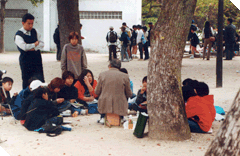
In the memorial park in Hiroshima I saw a group of Atomic bomb survivors telling their experiences to a group of children. The children looked very serious as they tried to understand the story. Mr. Ishimaru mentioned that even though children cannot fully understand the pain and activities that took place, it is still very important to continue to pass on our experiences. Eventually the children's response might relieve the suffering of Hiroshima.
|
|
|
 Sato: How has your relationship with stone changed after the introduction of machine?
Sato: How has your relationship with stone changed after the introduction of machine?













